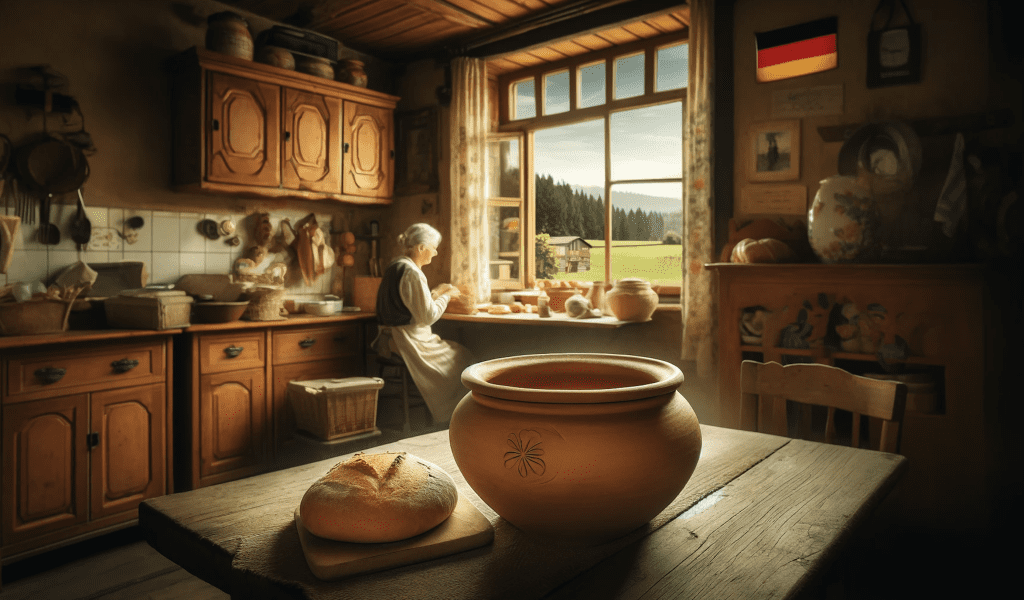Interessieren Sie sich für die einzigartige Welt des Kochens mit Tontöpfen? Begleiten Sie uns bei The Sourdough People, während wir die faszinierende Geschichte und Vielseitigkeit des deutschen Römertopfs erkunden. Erfahren Sie, warum dieser traditionelle Tontopf ein unverzichtbares Werkzeug zum Backen von perfektem Sauerteigbrot und vielem mehr ist. Entdecken Sie seine Ursprünge, kulturelle Bedeutung und verschiedene Formen und Typen und sehen Sie, wie er im Vergleich zu herkömmlichen gusseisernen Dutch Ovens abschneidet. Unser umfassender Leitfaden bietet Ihnen alles, was Sie über die Verwendung eines Römertopfs in Ihrer heimischen Küche zum Backen von Sauerteig wissen müssen. Tauchen Sie ein in die reichen Traditionen und modernen Vorteile dieses zeitlosen Kochgefäßes.
In the world of cooking, there are few tools that have withstood the test of time quite like the Römertopf. This clay pot, hailing from Germany, has garnered a reputation for its ability to create moist, flavorful dishes that delight the senses. In this article, we’ll delve into the fascinating world of the Römertopf, exploring its history, uses, cultural significance, and what sets it apart from other cooking vessels. Whether you’re a seasoned chef or a home cook looking to expand your culinary repertoire, the Römertopf offers a unique way to enhance your kitchen creations and experiment with sourdough bread in a new way.
What is a Römertopf?
A Römertopf, which translates to “Roman pot” in German, is a type of clay baking dish that has been used for centuries. Made from all-natural, porous clay, the Römertopf is designed to be soaked in water before use. This allows the clay to absorb moisture, which is then slowly released during the cooking process. The result is a self-basting environment that keeps food tender and succulent, enhancing flavours and retaining nutrients. The Römertopf’s unique ability to maintain moisture is particularly beneficial for baking bread, such as sourdough, where a crisp crust and soft interior are highly desirable.
What Are They Used For?
The versatility of the Römertopf makes it an invaluable addition to any kitchen. It’s primarily used for baking bread, roasting meats, and cooking stews, but its uses extend far beyond these staples. Vegetables, fish, and even desserts can be prepared in a Römertopf, each benefiting from the gentle, even heat distribution and moisture retention that this unique pot provides. The Römertopf’s ability to create perfectly baked bread with a crispy crust and soft interior has made it particularly beloved among sourdough enthusiasts. Additionally, its natural composition means that no artificial chemicals or non-stick coatings interfere with the purity of your ingredients, making it a healthy choice for conscientious cooks.
Where Did They Come From?
The origins of the Römertopf can be traced back to ancient Roman times, where similar clay pots were used for cooking. However, the modern Römertopf as we know it was developed in Germany in the 1960s by Bay Keramik. Drawing inspiration from traditional Roman methods, the German creators sought to revive and modernize this ancient cooking technique. Their efforts resulted in the Römertopf gaining popularity not only in Germany but also internationally, as cooks around the world discovered its unique benefits. The Römertopf’s design reflects a blend of ancient wisdom and modern ingenuity, making it a timeless tool in any kitchen.
How Do They Relate to German Culture?
In Germany, the Römertopf is more than just a cooking vessel; it is a cherished part of culinary tradition. The practice of using clay pots for cooking is deeply rooted in German culture, reflecting a broader European heritage of clay baking. German cuisine, known for its hearty and wholesome dishes, finds a perfect partner in the Römertopf. It embodies the German culinary philosophy of using simple, high-quality ingredients and traditional techniques to create delicious, nourishing meals. The Römertopf’s role in baking traditional German breads, such as sourdough, highlights its significance in maintaining and celebrating cultural culinary practices.
Forms and Types of Römertopf
Römertopf pots come in various shapes and sizes to accommodate different cooking needs. Here are some of the most popular forms:
Classic Rectangular Römertopf:
-Ideal for roasting meats, baking bread, and cooking casseroles.
-Available in various capacities to suit different meal sizes.
Round Römertopf:
-Perfect for stews, soups, and round loaves of bread.
-Provides even heat distribution for consistent cooking results.
Bread Baker Römertopf:
-Designed specifically for baking bread, with a ridged bottom to create beautiful patterns on the crust.
-Helps achieve the perfect balance of crispy crust and soft interior.
Fish Baker Römertopf:
-Elongated shape ideal for cooking whole fish.
-Ensures the fish remains moist and tender.
Mini Römertopf:
-Smaller size suitable for individual portions or side dishes.
-Great for experimenting with different recipes in smaller quantities.
Glazed Interior Römertopf:
-Easier to clean while still offering the benefits of clay cooking.
-Available in various shapes and sizes to match different cooking needs.
Each type of Römertopf offers specific advantages depending on what you plan to cook, making them versatile tools that can cater to a wide range of culinary applications.
Römertopf vs. Regular Dutch Ovens
While both Römertopf pots and Dutch ovens are used for slow cooking, they differ in material and cooking method. Dutch ovens, typically made from cast iron, provide excellent heat retention and are often used on the stovetop as well as in the oven. In contrast, Römertopf pots are made from clay and require soaking in water before use. This soaking process allows the Römertopf to create a steamy environment inside the pot, resulting in exceptionally moist and flavourful dishes. The porous nature of the clay also means that Römertopf pots can breathe, which enhances the flavor profile of the food. Unlike Dutch ovens, which can be quite heavy, Römertopf pots are generally lighter and easier to handle, making them accessible for cooks of all ages.
Unique Facts and Nuances about Römertopf
One of the unique features of the Römertopf is its ability to improve with use. Over time, as the pot absorbs more flavors and becomes seasoned, it can enhance the taste of the dishes cooked in it. Another interesting aspect is that Römertopf pots can be used in both conventional and microwave ovens, offering flexibility in cooking methods. It’s also worth noting that the Römertopf’s design allows for easy serving; the pot can go directly from the oven to the table, keeping food warm and presenting it beautifully. Additionally, the natural clay material of the Römertopf means that it is an environmentally friendly option, as it is free from harmful chemicals and fully biodegradable.
Closing Thoughts
The Römertopf is a testament to the enduring appeal of traditional cooking methods. Its ability to create moist, flavorful dishes with minimal effort makes it a valuable tool for both novice cooks and experienced chefs. By embracing the Römertopf, you’re not only adopting a versatile and efficient cooking method but also connecting with a rich culinary heritage that spans centuries dating back to ancient Rome. Whether you’re baking bread, roasting a succulent chicken, or preparing a hearty stew, the Römertopf promises to elevate your culinary creations to new heights. So, immerse yourself in the art of clay pot cooking and discover the magic of the Römertopf in your kitchen. With its unique benefits and rich history, the Römertopf is sure to become a cherished part of your culinary journey, especially for those passionate about sourdough baking.





















